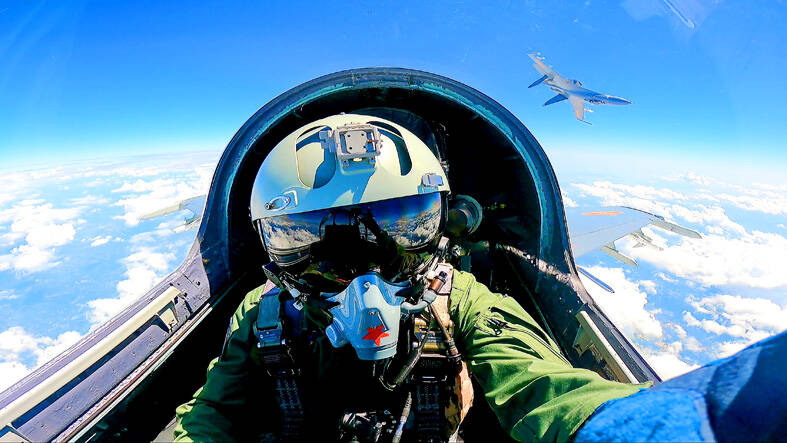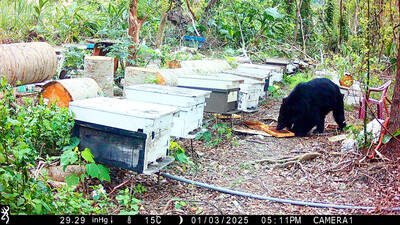China’s most recent military drills around Taiwan revealed shortcomings that continue to pose challenges to Beijing, despite its efforts to modernize its forces, a researcher said on Friday.
China conducted drills that involved 232 air sorties from April 8 to Monday last week, 35 sorties on Tuesday and 26 sorties on Wednesday, National Policy Foundation associate research fellow Chieh Chung (揭仲) said.
The drills showed that the Chinese military made significant improvements in formation flights, individual pilot skills and operational air control, but deficiencies in key capabilities were also apparent, he said.

Photo: EPA-EFE / XINHUA / Mei Shaoquan
Although China flew a record-breaking number of sorties, they did not exceed the sophistication displayed in drills involving 149 sorties from Oct. 1 to 4, 2021, he said.
China at the time practiced nighttime strike operations involving 25 planes, including fighter jets and bombers, that encroached on Taiwan’s southern and southeastern airspace under the guidance of airborne warning and air control systems (AWACS), he said.
During the most recent drills, China practiced sorties during the day and its strike groups did not carry out long-range penetration operations from bases along China’s coast, he said.
Although Chinese aircraft carrier Shandong launched 19 sorties on April 9 and Monday last week alongside China’s air force, there was little coordination between the units involved, he said, calling it China’s first-ever simulation of such a joint operation.
Chinese navy aircraft flew close to southeastern Taiwan, while jets operated by its air force flew near the Taiwan Strait’s median line, suggesting that China lacks the capability to use AWACS for such operations, Chieh said.
Only six sorties involved uncrewed aerial vehicles, an “absurdly low number” in light of the status of drones in China’s plans for a potential war in the Strait, he said.
The unimpressive practice of joint air and sea operations, sparse use of drones and a lack of nighttime flights suggest that the Chinese military has serious difficulties or tries to deceive its adversaries, he said.

SHIPS, TRAINS AND AUTOMOBILES: The ministry has announced changes to varied transportation industries taking effect soon, with a number of effects for passengers Beginning next month, the post office is canceling signature upon delivery and written inquiry services for international registered small packets in accordance with the new policy of the Universal Postal Union, the Ministry of Transportation and Communications said yesterday. The new policy does not apply to packets that are to be delivered to China, the ministry said. Senders of international registered small packets would receive a NT$10 rebate on postage if the packets are sent from Jan. 1 to March 31, it added. The ministry said that three other policies are also scheduled to take effect next month. International cruise ship operators

NUMBERS IMBALANCE: More than 4 million Taiwanese have visited China this year, while only about half a million Chinese have visited here Beijing has yet to respond to Taiwan’s requests for negotiation over matters related to the recovery of cross-strait tourism, the Tourism Administration said yesterday. Taiwan’s tourism authority issued the statement after Chinese-language daily the China Times reported yesterday that the government’s policy of banning group tours to China does not stop Taiwanese from visiting the country. As of October, more than 4.2 million had traveled to China this year, exceeding last year. Beijing estimated the number of Taiwanese tourists in China could reach 4.5 million this year. By contrast, only 500,000 Chinese tourists are expected in Taiwan, the report said. The report

The Forestry and Nature Conservation Agency yesterday launched a gift box to market honey “certified by a Formosan black bear” in appreciation of a beekeeper’s amicable interaction with a honey-thieving bear. Beekeeper Chih Ming-chen (池明鎮) in January inspected his bee farm in Hualien County’s Jhuosi Township (卓溪) and found that more than 20 beehives had been destroyed and many hives were eaten, with bear droppings and paw prints near the destroyed hives, the agency said. Chih returned to the farm to move the remaining beehives away that evening when he encountered a Formosan black bear only 20m away, the agency said. The bear

Chinese embassy staffers attempted to interrupt an award ceremony of an international tea competition in France when the organizer introduced Taiwan and displayed the Republic of China flag, a Taiwanese tea farmer said in an interview published today. Hsieh Chung-lin (謝忠霖), chief executive of Juxin Tea Factory from Taichung's Lishan (梨山) area, on Dec. 2 attended the Teas of the World International Contest held at the Peruvian embassy in Paris. Hsieh was awarded a special prize for his Huagang Snow Source Tea by the nonprofit Agency for the Valorization of Agricultural Products (AVPA). During the ceremony, two Chinese embassy staffers in attendance